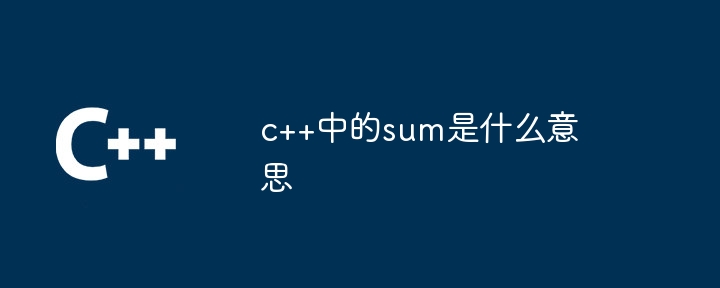What does sum mean in c++
In C, the sum function is used to calculate the sum of a list of numbers. It is a generic function that can handle various types of numbers. The usage is sum({a, b, c, ...}), where a, b, c, etc. are the numbers to be summed.

sum in C
In the C programming language, sum is a built-in function that calculates the sum of a series of numbers. It is a generic function that can handle various types of numbers, including integers, floating point numbers, and double precision floating point numbers.
Syntax
##sum(initializer_list
initializer_list is to be calculated A list of numbers whose sum, T is the type of number.
Usage
To use the sum function, you can use the following syntax:sum({a, b, c, ...});a, b, c, etc. are number.
Example
The following code example demonstrates the use of the sum function:#include <iostream>
#include <numeric>
int main() {
// 计算整数列表的和
int a[] = {1, 2, 3, 4, 5};
int sum_int = std::accumulate(a, a + 5, 0);
// 计算浮点数列表的和
float b[] = {1.2, 2.3, 3.4, 4.5, 5.6};
float sum_float = std::accumulate(b, b + 5, 0.0f);
// 输出结果
std::cout << "整数列表的和:" << sum_int << std::endl;
std::cout << "浮点数列表的和:" << sum_float << std::endl;
return 0;
}<code>整数列表的和:15 浮点数列表的和:17.000000</code>
The above is the detailed content of What does sum mean in c++. For more information, please follow other related articles on the PHP Chinese website!

Hot AI Tools

Undresser.AI Undress
AI-powered app for creating realistic nude photos

AI Clothes Remover
Online AI tool for removing clothes from photos.

Undress AI Tool
Undress images for free

Clothoff.io
AI clothes remover

AI Hentai Generator
Generate AI Hentai for free.

Hot Article

Hot Tools

Notepad++7.3.1
Easy-to-use and free code editor

SublimeText3 Chinese version
Chinese version, very easy to use

Zend Studio 13.0.1
Powerful PHP integrated development environment

Dreamweaver CS6
Visual web development tools

SublimeText3 Mac version
God-level code editing software (SublimeText3)

Hot Topics
 1371
1371
 52
52
 How to implement the Strategy Design Pattern in C++?
Jun 06, 2024 pm 04:16 PM
How to implement the Strategy Design Pattern in C++?
Jun 06, 2024 pm 04:16 PM
The steps to implement the strategy pattern in C++ are as follows: define the strategy interface and declare the methods that need to be executed. Create specific strategy classes, implement the interface respectively and provide different algorithms. Use a context class to hold a reference to a concrete strategy class and perform operations through it.
 Similarities and Differences between Golang and C++
Jun 05, 2024 pm 06:12 PM
Similarities and Differences between Golang and C++
Jun 05, 2024 pm 06:12 PM
Golang and C++ are garbage collected and manual memory management programming languages respectively, with different syntax and type systems. Golang implements concurrent programming through Goroutine, and C++ implements it through threads. Golang memory management is simple, and C++ has stronger performance. In practical cases, Golang code is simpler and C++ has obvious performance advantages.
 How to implement nested exception handling in C++?
Jun 05, 2024 pm 09:15 PM
How to implement nested exception handling in C++?
Jun 05, 2024 pm 09:15 PM
Nested exception handling is implemented in C++ through nested try-catch blocks, allowing new exceptions to be raised within the exception handler. The nested try-catch steps are as follows: 1. The outer try-catch block handles all exceptions, including those thrown by the inner exception handler. 2. The inner try-catch block handles specific types of exceptions, and if an out-of-scope exception occurs, control is given to the external exception handler.
 How to iterate over a C++ STL container?
Jun 05, 2024 pm 06:29 PM
How to iterate over a C++ STL container?
Jun 05, 2024 pm 06:29 PM
To iterate over an STL container, you can use the container's begin() and end() functions to get the iterator range: Vector: Use a for loop to iterate over the iterator range. Linked list: Use the next() member function to traverse the elements of the linked list. Mapping: Get the key-value iterator and use a for loop to traverse it.
 How to use C++ template inheritance?
Jun 06, 2024 am 10:33 AM
How to use C++ template inheritance?
Jun 06, 2024 am 10:33 AM
C++ template inheritance allows template-derived classes to reuse the code and functionality of the base class template, which is suitable for creating classes with the same core logic but different specific behaviors. The template inheritance syntax is: templateclassDerived:publicBase{}. Example: templateclassBase{};templateclassDerived:publicBase{};. Practical case: Created the derived class Derived, inherited the counting function of the base class Base, and added the printCount method to print the current count.
 What are the common applications of C++ templates in actual development?
Jun 05, 2024 pm 05:09 PM
What are the common applications of C++ templates in actual development?
Jun 05, 2024 pm 05:09 PM
C++ templates are widely used in actual development, including container class templates, algorithm templates, generic function templates and metaprogramming templates. For example, a generic sorting algorithm can sort arrays of different types of data.
 Why does an error occur when installing an extension using PECL in a Docker environment? How to solve it?
Apr 01, 2025 pm 03:06 PM
Why does an error occur when installing an extension using PECL in a Docker environment? How to solve it?
Apr 01, 2025 pm 03:06 PM
Causes and solutions for errors when using PECL to install extensions in Docker environment When using Docker environment, we often encounter some headaches...
 How to access elements in C++ STL container?
Jun 05, 2024 pm 06:04 PM
How to access elements in C++ STL container?
Jun 05, 2024 pm 06:04 PM
How to access elements in C++ STL container? There are several ways to do this: Traverse a container: Use an iterator Range-based for loop to access specific elements: Use an index (subscript operator []) Use a key (std::map or std::unordered_map)




